
Conference Day: Day 1 – November 1st 2017
Remarks – Evening of Celebration and Inspiration
Conference Day: Day 1 – November 1st 2017
Opening Remarks – Evening of Celebration and Inspiration

Conference Day: Day 1 – November 1st 2017

CSPC is proud to present its 3rd Annual Youth Science Policy Awards of Excellence which follows in the spirit of our 2013 Young Generation Award.
This award recognizes a young individual (student, postdoctoral fellow, researcher, entrepreneur, etc.) under the age of 35 who developed an innovative and compelling evidence-based policy proposal that will make a positive difference to Canadians.
Proposals were to be connected to one or more of the themes for the 2017 CSPC Conference. This award is designed not only to highlight innovative, evidence-driven policy ideas, but also to encourage innovative young people who may not currently be studying, or working on, public policy to develop and share their policy ideas.
The Selection Committee was so impressed by the quality of the submissions and the dedication of the applicants that they wanted to share the best of these innovative evidence based policy proposals with the CSPC community.
CSPC 2017 Science Policy Excellence Award – Youth (Download a PDF of the top 2017 Award proposals)
CSPC 2016 Science Policy Excellence Award – Youth (Download a PDF of the top 2016 Award proposals)
Congratulations to our 2017 winner Sierra Clark of McGill University for her proposal, “Residential wood-burning in Canada: Health and climate effects and intervention strategies”
Sierra Clark
And to our runners-up, Dr. Deena Hamza of the University of Alberta for her proposal, “A Proactive and Cost-Effective Approach to Reducing Mental Illnesses” and Meagan Grabowski of the Yukon Government for her proposal, “Modernizing the Yukon Scientists and Explorers Act”.
Dr. Deena Hamza
Meagan Grabowski
CLICK HERE TO WATCH THE CSPC 2017 AWARD OF EXCELLENCE CEREMONY
Documents:
CSPC 2017 Award Submissions
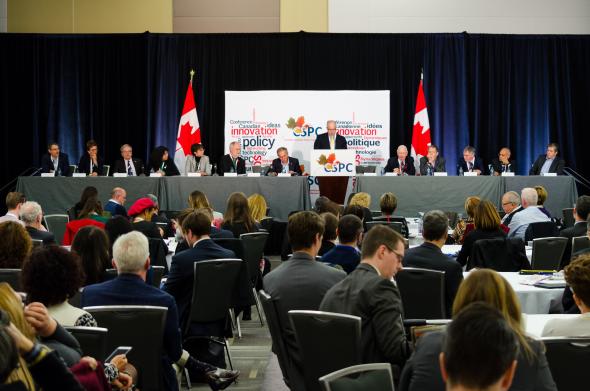
Conference Day: Day 1 – November 1st 2017
Organized by: Friends of the Canadian Institutes of Health Research
Keynote: Alan Bernstein, President and CEO, CIFAR, 2017 Henry G. Friesen International Prizewinner
Speakers: Brenda Andrews, Director, Andrew’s Lab, University of Toronto; Doina Precup, Associate Professor, McGill University; Dr Rémi Quirion, Chief Scientist of Quebec; Linda Rabeneck, Vice President, Prevention and Cancer Control, Cancer Care Ontario; Peter Zandstra, Director, School of Biomedical Engineering, University of British Columbia
Discussants: Henry Friesen, Professor Emeritus, University of Manitoba; Roderick McInnes, Acting President, Canadian Institutes of Health Research and Director, Lady Davis Institute, Jewish General Hospital, McGill University; Duncan J. Stewart, CEO and Scientific Director, Ottawa Hospital Research Institute; Vivek Goel, Vice President, Research and Innovation, University of Toronto
Moderators: Eric Meslin, President & CEO, Council of Canadian Academies; André Picard, Health Reporter and Columnist, The Globe and Mail
Takeaways and recommendations:
The opportunity for Canada
- The potential impact of artificial intelligence (AI) could be as significant as the industrial revolution of the 19th century.
- Canada’s global advantage in deep learning (a subset of machine learning) stems from the pioneering work of Geoffrey Hinton and early support from CIFAR and NSERC.
- AI could mark a turning point in Canada’s innovation performance, fueled by the highest levels of venture capital financing in nearly a decade, and underpinned by publicly funded research at the federal, provincial and institutional levels.
- The Canadian AI advantage can only be fully realized by developing and importing skilled talent, accessible markets, capital and companies willing to adopt new technologies into existing industries.
- Canada leads in the combination of functional genomics and machine learning which is proving effective for predicting the functional variation in genomes.
- AI promises advances in biomedical engineering by connecting chronic diseases – the largest health burden in Canada – to gene regulatory networks by understanding how stem cells make decisions.
- AI can be effectively deployed to evaluate health and health systems in the general population.
The challenges
- AI brings potential ethical and economic perils and requires a watchdog to oversee standards, engage in fact-based debate and prepare for the potential backlash over job losses to robots.
- The ethical, environmental, economic, legal and social (GEL3S) aspects of genomics have been largely marginalized and it’s important not to make the same mistake with AI.
- AI’s rapid scientific development makes it difficult to keep pace with safeguards and standards.
- The fields of AI’s and pattern recognition are strongly connected but here is room for improvement.
- Self-learning algorithms such as Alphaville could lead to the invention of new things that humans currently don’t know how to do. The field is developing rapidly, leading to some concern over the deployment of such systems.
Training future AI professionals
- Young researchers must be given the oxygen to excel at AI if its potential is to be realized.
- Students appreciate the breadth of training and additional resources they receive from researchers with ties to both academia and industry.
- The importance of continuing fundamental research in AI is being challenged by companies such as Facebook, Google and Amazon which are hiring away key talent.
- The explosion of AI is a powerful illustration of how the importance of fundamental research may only be recognized and exploited after 20 or 30 years. As a result, support for fundamental research, and the students working in areas related to AI, must continue.
Documents:
CSPC 2017 Takeaway: AI
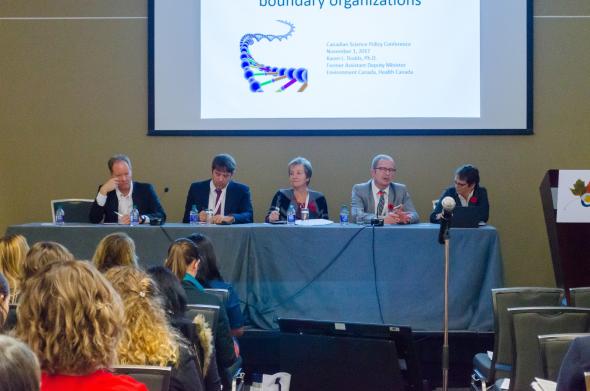
Conference Day: Day 1 – November 1st 2017
Organized by: Marc Saner, Institute for Science, Society and Policy, University of Ottawa
Speakers: Frédéric Bouchard, President, ACFAS (Association francophone pour le savoir);
Karen Dodds, Former Assistant Deputy Minister, Environment and Climate Change Canada;
Johannes Klumpers, Head of Unit, Scientific Advice Mechanism, European Commission;
Marc Saner, Professor, University of Ottawa
Moderator: Sonia L’Heureux, Parliamentary Librarian, Library of Parliament
Takeaways and recommendations:
- The formulation of questions put to boundary organizations should be examined.
- Questions and interests can shift rapidly, especially in a policy-relevant environment.
- Engage in a dialogue and make the questions and expectations explicit: it requires going back and forth, and the courage to ask for clarification.
- Scientists should offer scientific input and advice, contributing their expertise provides a critical contribution to policy development
- Policymaking is a specific “craft” that has its own considerations and imperatives – e.g., timing pressures and incomplete information are constants that are part of the policymaking process
- Βoundary organizations can be a bridge to these two specialized functions
- Academics should be clear who their funders are and the policy motivation behind the funding.
- Think tanks are playing a broader role in policymaking with the emergence of a knowledge-based society. Historically, research and its findings were the purview of universities alone; now, trained researchers also work at boundary organizations, using research to support policy.
- The emergence of think tanks in society means knowledge plays an increasing role in decision-making and in society.
- Think tanks answer specific timely questions but are beholden to the question askers who fund their work.
- The Scientific Advice Mechanism is a boundary organization that advises the European Commission.
- There are several challenges for the Scientific Advice Mechanism:
- Delivering science advice within political timescales;
- Choosing effective evidence review techniques; and
- Communicating advice to policymakers and the public, particularly when it involves uncertainties.
Documents:
CSPC 2017 Takeaway: Contested Decisions
How to Create Dynamic Agri-food Regulatory Policy in an Era of Accelerating Technological Innovation
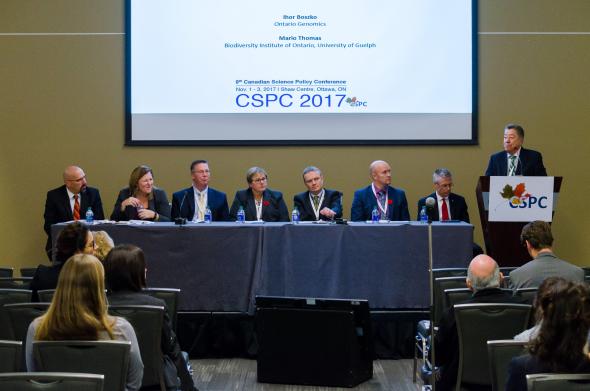
Conference Day: Day 1 – November 1st 2017
Organized by: Ihor Boszko, Ontario Genomics and Mario Thomas, University of Guelph
Speakers: Dr. Pierre Bilodeau, Executive Director, Science Branch Canadian Food Inspection Agency; Evan Fraser, Director, Arrell Food Institute, University of Guelph; Cornelia Kreplin, Executive Director, Bio Sector, Alberta Innovates Bio Solutions; Michael M. Lohuis, Vice-President, Research & Innovation, Semex Alliance; Crystal Mackay, President, Canadian Centre for Food Integrity; and Tyler Whale, President, Ontario Agri-Food Technologies
Moderator: Malcolm M. Campbell, Vice-President (Research), University of Guelph
Takeaways and recommendations:
Policy considerations
- Innovative agrifood regulations and policies require science-based evidence and the “right environment” to be successfully implemented.
- Policy/regulatory reforms have not kept up with pace of innovation; policy should drive/incent areas where innovation is most desired, needed and strategic.
- Canada needs a regulatory policy environment that allows Canadian organizations to adopt innovative technologies to remain competitive in an increasingly competitive global environment. Countries that lag in adopting new technology will fall behind global competitors.
- Use artificial intelligence to speed review of scientific literature to accelerate review and approval of new drugs.
- Technologies and policies must focus on improving global ag-systems, particularly for small acreage farms in developing countries.
- Develop a collaborative approach to technology/policy framework amongst like-mind nations.
- Fund policy and regulatory science.
- Enact recommendations pertaining to agriculture in the Advisory Council on Economic Growth report.
- Focus on sustainable growth that delivers safe, healthy and nutritious foods, while balancing challenges such as climate change, water use, overpopulation and antibiotic use in livestock.
- Look into allowing in “initial token offerings” (an online fundraising method) to fund new digital platform technologies for agriculture.
- Policies should reflect an industry that is evolving from traditional farm jobs (e.g. husbandry) to tech-savvy jobs like logistics and software.
- Measuring impact in agriculture is difficult because of the significant lag time from research to farm production; one solution is to measure outputs that build the sector’s capacity (e.g. number of post-secondary graduates, number and impact of scientific publications).
Building public trust
- Canada can build on its strength in food safety to become the trusted global leader in safe, nutritious and sustainable food.
- Governments need to take a leadership role in providing straightforward and science-based regulatory pathways that evaluate new and emerging technologies (e.g. gene editing) to counteract unsubstantiated claims on social media.
- Waning public trust in government agencies means that good science and regulatory approval are not enough to guarantee consumer acceptance of a product. The public needs to be engaged early in transparent discourse to build trust. Look to other countries for best practices.
- Provide the public with more data (e.g. tracking from farm to plate) to build trust. Consumers want an honest assessment of risks and rewards.
- Scientists and farmers rate high as trusted and credible sources, but they don’t have a voice.
- Look at forming a national certification program that is science-based.
- Develop policies that focus on safety; harmonize with like-minded jurisdictions; and ensure regulations enable experimentation.
- Create incentives for farmers to create breeding programs for crops and livestock that focus more broadly on environmental resilience and not just yield.
- Use plain language to communicate evidence, and make this information more readily available on social media and the mainstream media.
- Agricultural research should incorporate ethical, legal and social implications, as a condition of funding.
- Move agriculture from being a commodity to something that is an important health determinant (i.e. by building better connections between the agricultural community and the health community).
Documents:
CSPC 2017 Takeaway: Agrifood Policy
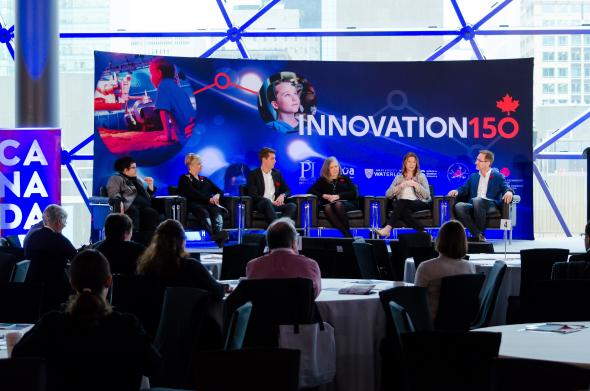
Conference Day: Day 1 – November 1st 2017
Organized by: Innovation150, a partnership supported by the Department of Canadian Heritage, between Perimeter Institute, Actua, the Institute for Quantum Computing at the University of Waterloo, the Canadian Association of Science Centres, and Ingenium.
Speakers: Andrew Campbell, Senior Executive Director, Canada 150 Federal Secretariat; Sandra Corbeil, Director, Strategic Partnerships and Networks, Ingenium; Tobi Day-Hamilton, Director, Communications and Strategic Initiatives, Institute for Quantum Computing at the University of Waterloo; Stephanie Deschenes, Executive Director, Canadian Association of Science Centres; Greg Dick, Director of Educational Outreach, Perimeter Institute; Jennifer Flanagan, President and CEO, Actua; RJ Taylor, Manager of Special Projects, Perimeter Institute
Takeaways and recommendations:
About Innovation150:
Innovation150 was a yearlong program that offered meaningful and enriching experiences across the country that fostered a culture of innovation and inspired the next generation of innovators. Delivered through a partnership between five leading science organizations, the collaborative Canada 150 project included:
- Power of Ideas — an interactive science exhibition from Perimeter Institute that travelled to schools and science centres across the country, reaching 100,000 youth and families in 180+ communities
- Actua Maker Mobile — a moving makerspace packed with exciting, cutting-edge technology that encourages youth to experiment and build with hands-on learning, reaching 12,000 youth through 300+ workshops from coast to coast to coast;
- QUANTUM: The Exhibition — from the Institute for Quantum Computing at the University of Waterloo, this feature exhibition was the first-ever travelling show on quantum information science and technology and reached more than 150,000 at seven venues throughout 2017;
- Innovation Festivals — hosted in part by science centres, five region-wide celebrations of innovation inspired curiosity through a wide range of activities from Innovation150 organizations and dozens of community-based partners throughout the country;
- Innovation150 Digital Hub — a go-to showcase about Canadian thinkers and new concepts, this online nexus for Innovation150 had a crowd-sourced innovation storybook from Ingenium, a range of exciting contests, and more, garnering over 1 million pageviews and 2.5 million clicks, likes, and shares on social media;
- Public Awareness Campaign — this far-reaching campaign celebrating Canadian innovators reached over 20 million Canadians with promotions, media engagement, online content, and national Public Service Announcements.
Partnering with the federal government:
- Government played an important role in funding, promotion and coordination.
- The Innovation150 vision, combined with funding from the federal government, provided a raison d’être for partners to come together under a common purpose.
- Government was flexible in allowing adaptive partnership funding models (i.e. between public, private and not-for-profit sectors).
- Government’s hands-off approach allowed Canadians and Canadian organizations to share unfiltered views on 150+ years of innovation.
Structuring the partnership:
- Develop common goals and a common vision, as well as relationships that extend beyond the outcomes.
- By joining forces, partners were able to reduce duplication and share resources and expertise.
- A lot of energy and engagement is needed at the front end to create a structure that was nimble, adaptable and responsive to each group’s needs. This is critical to building trust.
- This wasn’t five organizations with five different cultures; when including stakeholders, it is about 80 different organizational cultures. Personal interaction with partners on the ground is critical.
- A secretariat was formed.
- A memorandum of understanding identified potential challenges and opportunities for alignment and engagement; recognizing that each group has their own culture, mandate and deliverables.
- “Legacy over logos”: you need complete vertical buy-in from each organization, from executive level to people on the ground.
- A marketing communications sub-committee was struck to develop common branding.
- Partnerships work best when participants “check their egos at the door”
- Hold regular meetings and “check ins”.
- Each partner must be prepared to invest money, time, and resources to have a bigger impact.
- Each group needs a champion who can promote the importance of the partnership within their own organization.
Engaging communities
- Having Innovation150 led by its partners, and not the government, resulted in more community groups and their networks being involved. This broadened the reach and impact of Innovation150 and resulted in new linkages among community groups and other organizations.
- Having “boots on the ground” in each community made it possible to showcase how individuals can use innovation to solve problems in their homes, schools and communities; and why a science literate population is important.
- Overestimated the amount of promotional spend that would be required in communitiesbecause many partners at the community level brought (i) pre-existing media relationships that meant cost efficiencies, and (ii) existing people and organizational networks to spread the word quickly.
Lessons learned
- Bring organizations together in a formal partnership can yield much greater reach and impact, but this model is not necessarily cheaper — there are higher administration costs and organizational effort that need to be factored in from the start when considering a model like this. However, the final result will end up being much more than the sum of its parts.
- Securing funding from sponsors is resource- and energy-intensive, but the front end work is critical for long-term success.
- Be patient with your partner’s stakeholders; they may have concerns and reservations about the partnership that need to be understood and addressed through an open communications process.
- “Be open to knowing what you don’t know” and don’t be afraid to tap into the expertise of your partners.
- Employing extra diligence and seeking expert advice when developing project budgets is crucial.
Scaling up impact
- Successful projects often leveraged work that was already being done by other groups and networks, avoiding the need to start from scratch.
- Content was developed that could be adapted for use by the members of each partner’s network (e.g. the 50 science centres that are members of the Canadian Association of Science Centres).
- A focus on accessibility and inclusivity ensured projects reached the most Canadians, particularly those in rural, remote and indigenous communities (i.e. a mobile makers space, travelling science exhibition, innovation festivals, smaller pop-up exhibits).
- Several universities are creating their own maker mobiles modelled on the one created for Innovation150.
- Innovation festivals attracted more visitors than usual to local science organizations and facilities that local communities didn’t before know were in their backyards (e.g. Canadian Light Source).
- Partners and volunteers in each community leveraged their own networks and resources to reach more people.
- Developed professional public service announcements that broadcast stations ran for free; engaged sponsors (e.g. Shaw) that could provide more PSA airtime, reaching 20+ million Canadians.
- Used social media and contests to increase public engagement. This required constantly tweaking and testing digital content to understand what works and what doesn’t.
Building a lasting legacy
- Think big, start small and scale up; be persistent, be open and invite others to join.
- Connected the public to innovation already happening in their community, and showed them how to build that capacity at the local level.
- Ingenium developed a crowdsourced interactive digital storybook of Canadian achievements that people can continue to contribute to, comment on and share beyond 2017 (more than 760 stories to date).
- Created a digital hub – innovation150.ca – that organizations can use to share events and resources, including resources for teachers and parents
- Developed teacher resources that will allow educators to provide learning opportunities for their students around the knowledge and skills of innovation for years to come.
- Participants plan to incorporate much of what they learned into their regular programming.
- This experience has helped to build trust and long-term relationships between the partners, which are now looking at other ways to leverage their collective networks.
Documents:
CSPC 2017 Takeaway: Innovation150
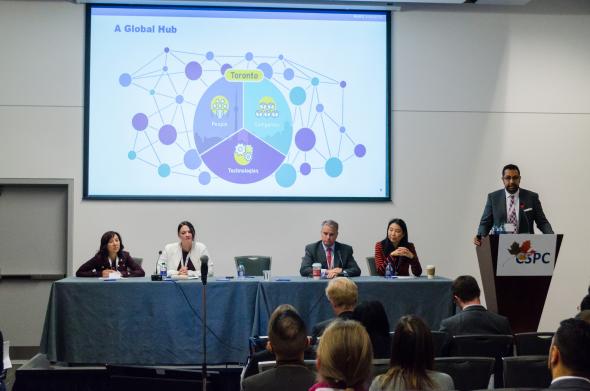
Conference Day: Day 1 – November 1st 2017
Organized by: Sean Lee, Head of External Relations, TRIUMF
Kathryn Hayashi, President and CEO, TRIUMF Innovations Inc; Gordon McCauley, President and CEO, Centre for Drug Research and Development; Parimal Nathwani, Vice President Life Sciences, MaRS Innovation; Laura O’Blenis, Co-Founder and Managing Director, Canadian Association of University Research Parks; Rebecca Yu, Vice President, Market Access & External Affairs, Takeda Canada.
Moderator: Karimah Es Sabar, CEO and Partner, Quark Venture Inc.
Takeaways and recommendations:
Successful KT models
- The Centre for Drug Research and Development acts as a global bridge between ideas and commercial opportunities with laboratories and in-house expertise, using a shared risk/reward model.
- TRIUMF Innovations Inc. is the commercialization arm of the TRIUMF, Canada’s national particle and nuclear physics facility, specializing in spin-offs, collaborations, licensing, technology assessment and partnering.
- MaRS Innovation operates in the “valley of death”, targeting high-potential projects for: milestone-based de-risking; intellectual property management (IP); assistance in company creation; interim management; and seed capital. Its start-ups remain in Canada and specialize in the areas of health information technology, medical devices and therapeutics.
- The Canadian Association of University Research Parks operates 27 parks in Canada, 75% of which have accelerator programs or incubator space.
- Takeda Canada brought its incubator model to Canada which focuses on public-private partnerships and targets Canadian technology firms seeking to go global.
Best practices for KT
- Growing, training and engaging local talent is an essential component of knowledge translation.
- Wrap experienced boards and advisors around emerging CEOs.
- When transferring knowledge to emerging companies, ask tough questions early, plan to scale and kill programs early if necessary.
Policy considerations
- Canada is only advanced life sciences nation without a large, domestic anchor company.
- Canada has ample funding for scientific development but needs to devote additional resources to IP development and marketing.
- Consider expanding the scope of the Scientific Research and Experimental Development tax credit program to include innovation activities such as marketing.
- Canada needs to make bigger bets and offer longer-term support as opposed to the current peanut butter approach of spreading knowledge translation efforts thinly.
- Canada needs to do a better job of attracting specialized talent. Often when recruited talent do not succeed in the short term, they stay awhile and return home.
- Canada must build up expertise in multiple verticals, followed by long-term commitment and focus by companies and government.
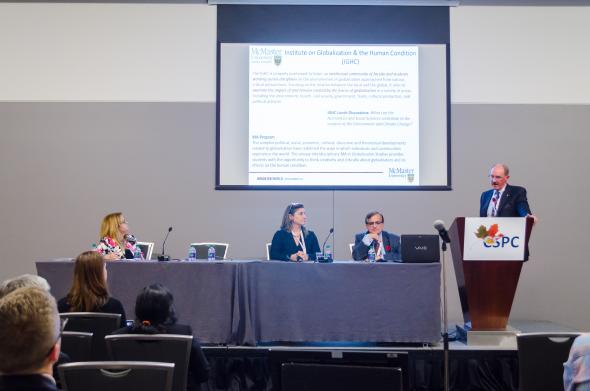
Conference Day: Day 1 – November 1st 2017
Panel Organizer: Rabiz Foda, Terre Policy Center, India
Takeaways and recommendations:
Health care and an aging population
- In solving energy and environmental issues, health and the aging population should be kept in mind
- Research is needed into how climate change affects the physical and mental health of older adults
- A fully connected home should integrate what people are doing and feeling. Healthcare can be conducted through virtual and augmented reality to connect people in their natural environments with health care providers
The role of universities
- To solve the problems of climate change, renewable energy, and smart cities, worldwide collaborations are required
- Universities should help students to develop a civic mission: embodying and enabling global citizenship
- Encourage co-supervision of graduate students across institutions, linking expertise of partnering universities, creating cooperation for mutual benefit
Smart Campus Cloud Network
- Learning through environmentally sustainable activities within the campus by using IoT and sharing through cloud dashboards creates positive competition between campuses on carbon footprints and other SDGs related campus initiatives. Campustime app helps in discussion forum on challenges, innovation and start-ups.
- Tangible contribution to UN Sustainable Development Goals by youth
- Develop energy apps like carbon footprint displays, enhance cooperation between students and researchers
- Big data – online data shared, compare daily consumption patterns
- Piloting the Smart cities in the smart campuses and making youth ‘ market-ready’.
Business innovation
- “It takes an innovation ecosystem to raise a start-up.”
- Expect commercialization of research to take 5-10 years for disruptive ideas.
- The new innovation ecosystem is in urban areas and smart cities (as important as federal and provincial levels).
Work is needed on the power and efficiency of batteries to make them feasible for use in healthcare monitoring and for wearables.
Documents:
CSPC 2017 Takeaway: Ride The Wave
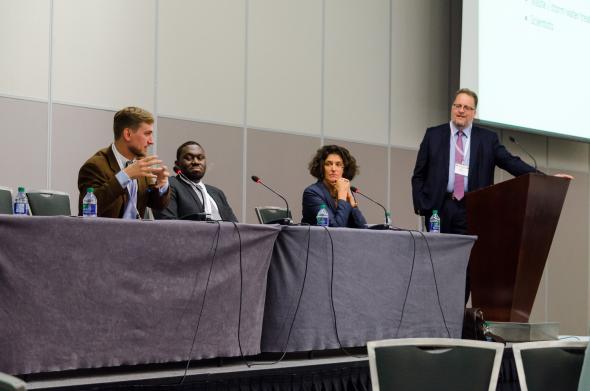
Part 1
Part 2
Part 3
Conference Day: Day 1 – November 1st 2017
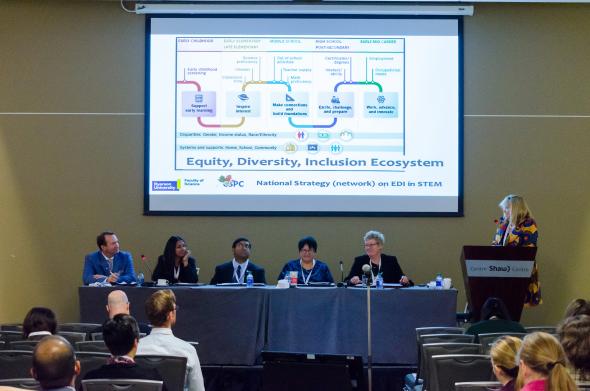
Part 1
Part 2
Part 3
Conference Day: Day 1 – November 1st 2017
Organized by: Imogen Coe, Professor; Dean, Faculty of Science, Ryerson University
Speakers: Shohini Ghose, Founding Director, Centre for Women in Science, Wilfrid Laurier University; Melanie Goodchild, Research Associate, Waterloo Institute for Social Innovation and Resilience (WISIR), University of Waterloo; Hilary Lappin-Scott, Senior Pro-Vice-Chancellor, Swansea University; Mahadeo Sukhai, Head of Research, CNIB; Luc Villeneuve, Canada Country Manager and General Manager, Red Hat Canada
Moderator: Imogen Coe, Professor; Dean, Faculty of Science, Ryerson University
Takeaways and recommendations:
Ideas to increase EDI in Canada
- Canada needs a national strategy for EDI (Equity, Diversity and Inclusion).
- There should be more events where under-represented groups can share their stories and gain confidence (e.g. the Soapbox Science program).
- The UK Athena SWAN program is an excellent model for achieving real change when it comes to gender and diversity goals.
- It is not just about achieving EDI goals for their own sake; the program has been shown to lead to improved research outputs and other traditional measures of excellence.
- More Canadian data on diversity issues is needed to understand what is changing.
Re-frame the dialogue
- EDI is about more than “women in science” or gender equity– it’s about diversity and inclusion, broadly. It is an issue of human rights, not women’s rights.
- EDI is also an economic imperative – we need all minds at the table to be a creative, innovative and productive society.
- Men and people from majority groups need to participate in this culture change by showing leadership, supporting under-represented groups and engaging actively in the conversation (while knowing when to stop talking and listen).
- Disability is among a range of human variations and we should re-frame the conversation around functional limitations rather than pathologies.
- The humanities in science should be valued (i.e. STEM -> STEAM). Science gives us information and data, and the arts give us context and meaning.
Increase the visibility of under-represented groups
- All people, including women, minorities and people with disabilities, need to be viewed as belonging in STEM professions.
- The number of scientists from under-represented groups celebrated in the school curriculum and generally within the Canadian context should be increased to properly acknowledge their role (so often ignored and forgotten) and to normalize the notion that scientists are from everywhere and all backgrounds.
- Re-work the curriculum to include a more diverse history of science beyond the European and North American context.
- Institutions in Canada should participate in more international events and celebrations (e.g. Ada Lovelace Day and International Women in Engineering Day).
Improve the education system
- Consider the impact of unconscious bias in education and train teachers to recognize it.
- Teach kids about colonialism and its effects in school.
- Recognize the non-linear nature of science and adapt the curriculum to reflect this.
- Teach young people, especially those who don’t fit into the dominant culture, bravery and resilience. Feed their love of growth and discovery.
- Re-think the questions of “what is science” and “who is science for” and who this excludes (e.g. we currently teach science in very visually dependent way, so it is often perceived that those who are blind or partially sighted cannot be scientists).
- Value that people have different kinds of abilities to bring to STEM (e.g. sign language has been found to be very effective in teaching certain concepts).
- Educate teachers on the power they have on people’s careers. If they discourage children from pursuing certain subjects after a certain age, the student may become dissuaded from following any path and simply drop out.
- Consider Indigenous perspectives when attempting to design and implement STEM programming in Indigenous communities or it will not be successful. Some of the elements to consider:
- English as a language affects how we perceive and interact with our world and tends to alienate many Indigenous people from pursuing subjects like STEM.
- Classroom settings take students off the land and do not honour land-based knowledge.
- Spirituality is often left out of the classroom experience.
- Ideas to combat these issues can come from Indigenous knowledge and communities. They should be part of the development process from the beginning.
Change the default thinking in organizations
- Be intentional about all levels of hiring and programming – internships, management, staff, etc. – and embed EDI principles at all stages.
- Provide unconscious bias and EDI training to everyone – institution wide. Ensure ageism is also part of this conversation.
- Providing bystander training is important as it gives people the tools and skills to intervene in situations that may be targeting or triggering to certain groups.
- Be conscious of how language is used. For example, do not think of it as an accessibility plan, but rather an inclusiveness plan. The question should not be “how do we accommodate” but “how do we ensure everyone is engaged?”
Change the institutional culture
- A person working or studying in an institution should feel comfortable bringing their whole self. This allows them to work their hardest/best to greater economic and social benefit.
- Actively consider what it feels like to be in an institution:
- What normal behaviours might be excluding people (e.g. is it OK to talk about children)?
- What messages does the physical space send (e.g. are the hallways decorated with pictures of white men)?
- Institutions should be explicit about their values and include EDI commitments in those values.
- Institutions developing reconciliation approaches need to involve representatives from the appropriate Indigenous community from the beginning – it will not work to insert them in later or bring them on as experts when the development is already three—quarters done.
- These processes have to be trauma-informed and those who are creating them within institutions have to be ready for and respectful of anger, and ready to hear and listen to differing opinions and perspectives.
Reduce the “minority tax”
- People from under-represented groups often have many burdens on their time and it can be exhausting and stressful to be the “lone voice” of a community.
- To reduce overburdening the same individuals by repeatedly calling on them, develop a wide and diverse pool from which to choose for committees, panels, boards, etc. Cultivate a list of willing participants over time that you can draw from, and that you can share with others if they make the claim that “diversity is too difficult”.
- Ask people to participate based on what they know – i.e. their subject matter expertise – and not what you think they might be or be like based on labels or categories you are trying to fill.
- Value these extra efforts and/or roles with direct rewards like promotion, monetary compensation or awards.
- Train all committee/board members in EDI so that everyone shares the responsibility of ensuring any decisions or outcomes are diverse and equitable.
Direct grant money to researchers engaging in EDI
- Tri-councils must enact policies that ensure all grants promote the importance of EDI; explicitly include ranking and reward for researchers who embed them in their proposals.
- There has to accountability and consequences if reviewers are not properly ranking or respecting EDI criteria.
- Instruct grant committees that embedding EDI principles in a proposal is a sign of merit and strength in research, and not just the “politically correct” thing to do.
- Ensure reviewers take a module on respecting and rewarding EDI (NSERC currently offers this in some cases) and include unconscious bias training.
- Individuals must participate in EDI training to sit on review panels.
Responsibilities of individuals within institutions
- Acknowledge your relative privileges and actively consider how you can change the culture around you.
- Be empathetic to the situation of others and call out bad behavior if/when you feel safe doing so (be bold!).
- If you find yourself in a position of relative power, learn to share your platforms (professional and otherwise) with people who have different worldviews.
- Make space, move over, listen to differing voices and make room for others.
- Become a coach – give time intentionally and regularly to encourage people and, if relevant, help them become visible to those in positions of power (management, etc.)
Documents:
CSPC 2017 Takeaway: Embedding Equity, Delivering Diversity
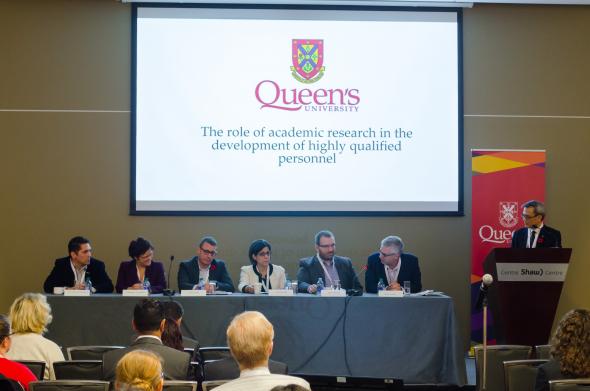
Part 1
Part 2
Conference Day: Day 1 – November 1st 2017
Organized by: Queen’s University
Speakers: Cathleen Crudden, Tier 1 Chair in Metal Organic Chemistry, Queen’s University; Marc Fortin, Vice-President Research Partnerships Directorate, NSERC; Art McDonald, Professor Emeritus, Queen’s University, 2015 Nobel Laureate in Physics; Sean Mercer, Environmental R&D Program Leader, Imperial Oil; Lisa Powell, Distinguished Professor and Director, Health Policy and Administration, University of Illinois at Chicago, Dan Sinai, Senior Executive, Innovation, IBM Canada; Jesse Vincent-Herscovici, Acting Vice-President, Business Development, Mitacs Inc.; Daniel Woolf, Principal and Vice-Chancellor, Queen’s University
Moderator: Ted Hsu, former MP for Kingston and the Islands and former Liberal opposition critic for Science and Technology and Post-Secondary Education
Takeaways and recommendations:
Effective training models
- NSERC’s Collaborative Research and Training Experience (CREATE) Program has been effective in changing the culture of the academic department it operates in by introducing millennial researchers who challenge the status quo, inject diversity and don’t display the risk aversion of their older colleagues. CREATE program budget should be significantly increased as it is an effective mechanism for enhancing soft skills.
- Mitacs has emerged as a major player in HQP training. Its internships act as an effective conduit or human bridge between academia and industry.
- HQP training must include emerging fields of expertise such as artificial intelligence, blockchain, augmented reality and high-performance computing.
- Universities and colleges have augmented their HQP training with regional innovation centres, incubators and cutting-edge research infrastructure supported by the Canada Foundation for Innovation, which is a huge change from 20 years ago.
- The U.S. National Institutes of Health has introduced a Next Generation Researchers Initiative to address longstanding challenges faced by researchers embarking on and sustaining independent research careers, as well as promoting the growth, stability and diversity of the biomedical research workforce.
Policy considerations
- The appetite for HQP by smaller firms and start-ups is staggering and outstrips supply. Universities must do a better job of conveying to undergraduate students the range of jobs available to them.
- Canada needs an honest assessment of its support for inter-disciplinary and international expertise.
- Key ingredients above and beyond disciplinary expertise must include critical thinking and the ability to effectively collaborate.
- Change STEM (science, technology, engineering and math) to STEAM (science technology, engineering, arts and math).
- Post-secondary HQP policy should include an emphasis on attracting women into STEAM by including mandatory gender training to redress the shortfalls of past hiring practices.
- HQP is at the top of the priority list for the OECD’s G20 Training Strategy.
- HQP training would benefit Canada in the areas of climate change and clean energy as a key measure to close the innovation gap with other countries and remain internationally competitive. Training and professional development should be part of national policy.
- HQP training must include exposure to global value chains, an area where Canada is currently weak.
- The Fundamental Science Review’s recommendation to boost support to the granting councils by $1.3 billion is a major opportunity to increase and enhance HQP training.
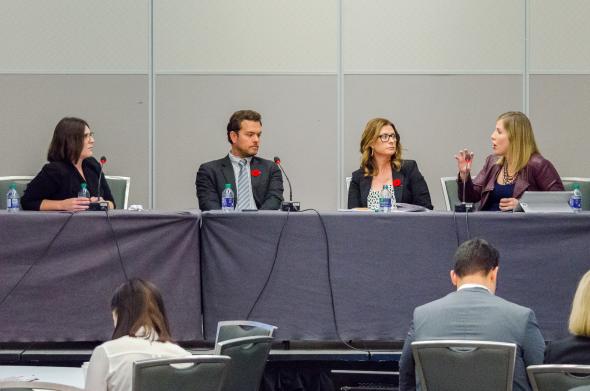
Conference Day: Day 1 – November 1st 2017
Organized by: Tracy Ross, Actua
Speakers: Brian Aspinall, Teacher, Speaker Coder, Maker; Jennifer Flanagan, Co-Founder, President and CEO, Actua; Melissa Sariffodeen, Co-founder, Ladies Learning Code
Moderator: Marlene Floyd, National Director, Corporate Affairs, Microsoft
Takeaways and recommendations:
Digital literacy is more essential than ever
- Digital literacy is more than learning code or programming languages. It is about experiential learning, solving real-world problems, critical thinking and understanding the impact of technologies like artificial intelligence on their life.
- Students who are not well versed in these areas will miss out on many careers, not just computer science.
- We need a diversity of individuals building technologies to solve problems. This can prevent problems like when the first voice recognition software did not recognize female voices.
Government support is important
- Recent federal funding has reinforced the importance of digital literacy and organizations that work in the field are finding it easier to get support. Corporate sponsors are more likely to sponsor again because they see their contribution having an amplified impact.
- CANCODE is good first step but more is needed to recognize the importance of digital literacy to the innovation ecosystem. Sustained support from government is needed.
- The current climate presents an opportunity for the federal government to guide school boards across the country to incorporate digital literacy fully in their curriculum.
The curriculum should be updated
- When developing curriculum for coding and other digital literacies schools should focus on the human element as well as the technical skills – the context of how students will use the skills is as or more important than the skill itself.
- Inspire and equip youth on how to use coding to solve problems that matter to them.
- Exposure to digital literacy (e.g. an hour of code every now and then) de-mystifies it, but children also need sustained engagement over a number of years.
- Digital skills programs meant to engage Indigenous youth need to be Indigenous-led at all stages – from planning, to design, to implementation – to properly meet the needs of the community and be successful.
- School evaluation methods should move from a grade-based approach (i.e. “what did I get”) to a knowledge construction/evaluating process (i.e. “what did I learn”).
- Students should be taught about empathy, emotional intelligence and design thinking.
- The digital literacy conversation should be about a disruption in the education process, not just getting a smartboard into the classroom.
- Corporate volunteers in digital literacy education have value but not everyone should be teaching kids directly. There needs to be a rigorous selection process and training.
- The informal learning space is essential because it can be designed without the shortcomings of formal systems.
Parents play a role
- Parents need to support and help their children; to do this they have to be taught to recognize the importance of digital skills beyond just getting a “computer” job.
- Parents need to understand online safety and digital citizenship.
- If parents are worried about too much screen time, they should be shown the value of digital literacy and taught that not all computer time is the same.
Documents:
CSPC 2017 Takeaway: Teaching Kids to Code




